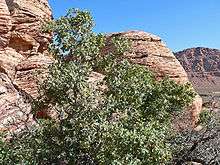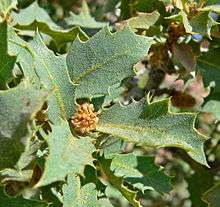Quercus turbinella
| Quercus turbinella | |
|---|---|
 | |
 | |
| Scientific classification | |
| Kingdom: | Plantae |
| (unranked): | Angiosperms |
| (unranked): | Eudicots |
| (unranked): | Rosids |
| Order: | Fagales |
| Family: | Fagaceae |
| Genus: | Quercus |
| Species: | Q. turbinella |
| Binomial name | |
| Quercus turbinella Greene 1889 | |
 | |
| Natural range | |
| Synonyms[1] | |
| |
Quercus turbinella is a North American species of oak known by the common names Sonoran scrub oak, shrub live oak, and grey oak.[2] It is native to northwestern Mexico and the southwestern United States[3]
Distribution
Quercus turbinella has been found in Baja California, Sonora, Arizona, New Mexico, Colorado, Utah, Nevada, southern California, and western Texas.[4][5] It has to date not been found in Chihuahua, but some of the known populations in Sonora and New Mexico lie only a few kilometers from the Chihuahuan border, so it is to be looked for in that state.[6] It grows in woodland, chaparral, forest, and other habitat. It is most common in chaparral habitat in central Arizona,[7] through the transition zone of the Mogollon Rim–White Mountains, but also southeast Arizona in the Madrean Sky Island mountain ranges of sky islands.[3]
Description
Quercus turbinella is a shrub growing 2–5 meters (6.6–16.4 ft) in height but sometimes becoming treelike and exceeding 6 meters (20 feet). The branches are gray or brown, the twigs often coated in short woolly fibers when young and becoming scaly with age. The thick, leathery evergreen leaves are up to 3 centimeters (1.2 inches) long by 2 cm (0.79 in) wide and are edged with large, spine-tipped teeth. They are gray-green to yellowish in color and waxy in texture on the upper surfaces, and yellowish and hairy or woolly and glandular on the lower surfaces. The males catkins are yellowish-green and the female flowers are in short spikes in the leaf axils, appearing at the same time as the new growth of leaves. The fruit is a yellowish brown acorn up to two centimeters long with a shallow warty cup about a centimeter wide.[8] This oak reproduces sexually via its acorns if there is enough moisture present, but more often it reproduces vegetatively by sprouting from its rhizome and root crown.[7][9]
Quercus turbinella easily hybridizes with other oak species, including Quercus gambelii and Q. grisea.[7] Many species of animals use it for food, with wild and domesticated ungulates browsing the foliage and many birds and mammals eating the acorns.[7] Animals also use the shrub as cover, and mountain lions hide their kills in the thickets.[7]
References
| Wikimedia Commons has media related to Quercus turbinella. |
- ↑ The Plant List, Quercus turbinella Greene
- ↑ "Calphotos photo gallery University of California".
- 1 2 Little. Atlas of United States Trees, Volume 3, Minor Western Hardwoods, Map 147, Quercus turbinella.
- ↑ Biota of North America Propgram 2014 county distribution map
- ↑ Calflora taxon report, University of California, Quercus turbinella E. Greene, Grey oak, Sonoran scrub oak, shrub live oak
- ↑ SEINet, Southwestern Biodiversity, Arizona chapter photos, description, interactive distribution map
- 1 2 3 4 5 US Forest Service Fire Ecology
- ↑ Virginia Tech: Shrub live oak Archived May 9, 2011, at the Wayback Machine.
- ↑ Flora of North America, Quercus turbinella Greene, 1889. Sonoran scrub oak
External links
- CalFlora Database: Quercus turbinella (Grey oak, Sonoran scrub oak, shrub live oak)
- Jepson eFlora treatment of Quercus turbinella
- United States Department of Agriculture Plants Profile for Quercus turbinella (Sonoran scrub oak)
- Flora of North America; flora of North America RangeMap
- Quercus turbinella in the CalPhotos Photo Database, University of California, Berkeley